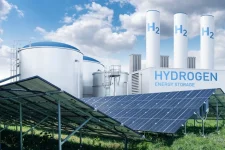HDF Energy from France keeps making progress on its big Renewable project near Swakopmund. They're putting together solar power, batteries, and green hydrogen all in one place. The plant spreads across 400 hectares of land and should make 142 gigawatt-hours of clean electricity every year. This amount equals almost 10% of what Namibia needs.
Foreign investors contributed most of the N$4.5 billion for this project. The plan fits perfectly with Namibia's Vision 2030 goals and Green Hydrogen Strategy. When European Union representatives visited the site, HDF Energy director Nicolas Lecomte discussed how important international teamwork has been. He mentioned that they had almost finished negotiating the business details.
Lecomte explained they just need to secure one final agreement before they start building, hopefully this year. He thanked the European Union for their important help through money grants that keep electricity prices affordable for Namibians. He pointed out that the coast needs lots of power but currently receives electricity from far away. His project brings power right where people need it.
HDF Energy teams up with NamPower to finish planning how everything will run, including when to send power and how to connect with the existing grid. The project creates about 2,000 jobs when you count direct work, support services, and related businesses. At least 600 people will work during the building phase and when the plant runs.
Tashiya Walenga leads HDF in Namibia and believes the Swakopmund project will open doors for more green hydrogen work later. She said they first wanted to help Namibia depend less on buying power from other countries, which currently supplies 70% of what Namibians use. They also research using hydrogen for trains and ships and making green ammonia to sell internationally.
Walenga explains that hydrogen power plants make perfect sense because they're straightforward solutions for energy security. She stated that Namibia will have the first big hydrogen plants because the technology works well, costs make sense, and it fixes an urgent problem. Building should begin around late 2025 and take two years, with everything running by 2028.
Ana-Beatriz Martins, who represents the European Union in Namibia, emphasized how valuable the partnership between Namibia and Europe has become for clean energy progress. She praised HDF Energy Namibia for helping mix renewable power into the country's electricity system. When Namibia makes its electricity grid greener, local products can earn green labels that bring tax breaks and other advantages.
Foreign investors contributed most of the N$4.5 billion for this project. The plan fits perfectly with Namibia's Vision 2030 goals and Green Hydrogen Strategy. When European Union representatives visited the site, HDF Energy director Nicolas Lecomte discussed how important international teamwork has been. He mentioned that they had almost finished negotiating the business details.
Lecomte explained they just need to secure one final agreement before they start building, hopefully this year. He thanked the European Union for their important help through money grants that keep electricity prices affordable for Namibians. He pointed out that the coast needs lots of power but currently receives electricity from far away. His project brings power right where people need it.
HDF Energy teams up with NamPower to finish planning how everything will run, including when to send power and how to connect with the existing grid. The project creates about 2,000 jobs when you count direct work, support services, and related businesses. At least 600 people will work during the building phase and when the plant runs.
Tashiya Walenga leads HDF in Namibia and believes the Swakopmund project will open doors for more green hydrogen work later. She said they first wanted to help Namibia depend less on buying power from other countries, which currently supplies 70% of what Namibians use. They also research using hydrogen for trains and ships and making green ammonia to sell internationally.
Walenga explains that hydrogen power plants make perfect sense because they're straightforward solutions for energy security. She stated that Namibia will have the first big hydrogen plants because the technology works well, costs make sense, and it fixes an urgent problem. Building should begin around late 2025 and take two years, with everything running by 2028.
Ana-Beatriz Martins, who represents the European Union in Namibia, emphasized how valuable the partnership between Namibia and Europe has become for clean energy progress. She praised HDF Energy Namibia for helping mix renewable power into the country's electricity system. When Namibia makes its electricity grid greener, local products can earn green labels that bring tax breaks and other advantages.












